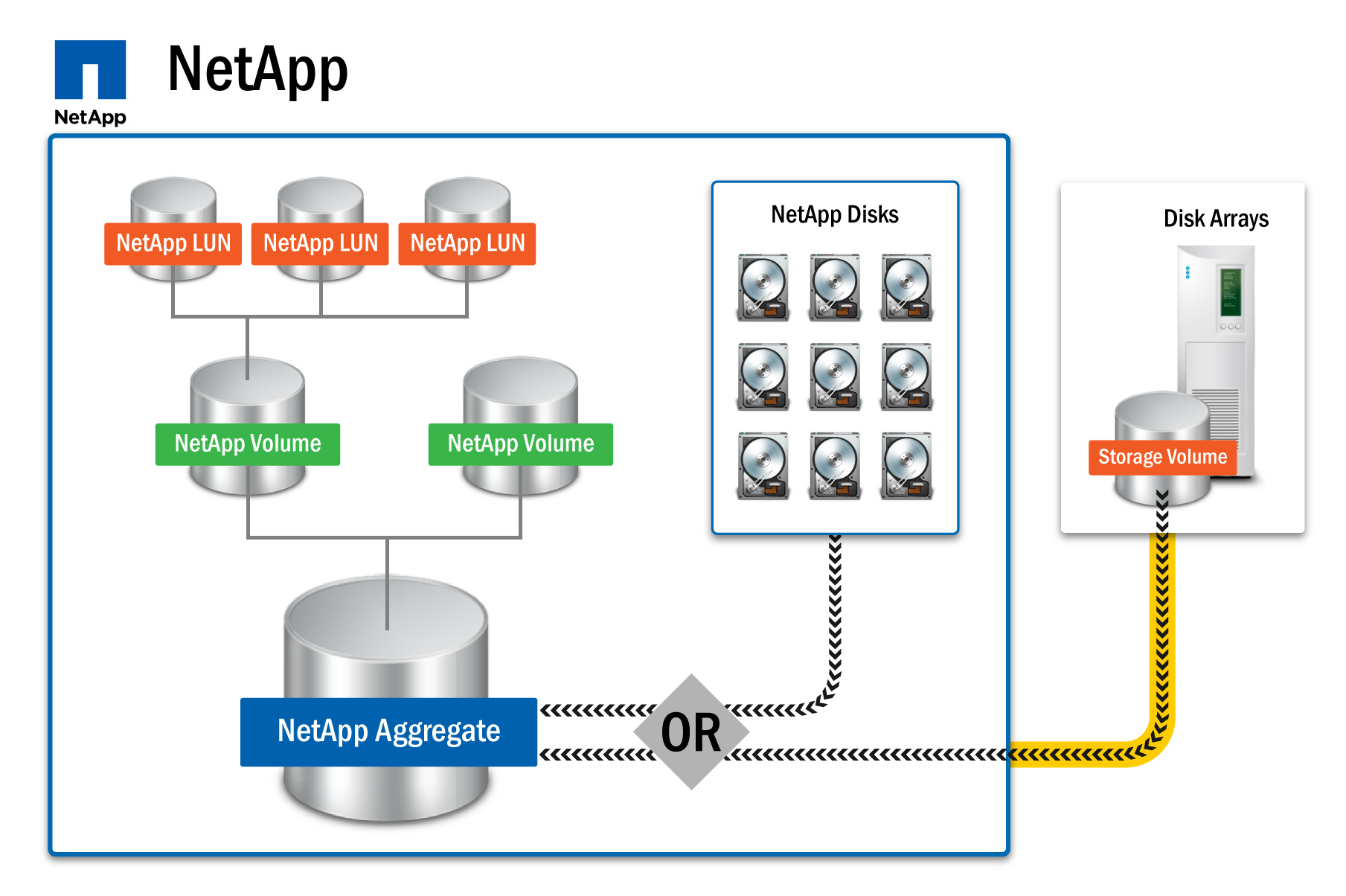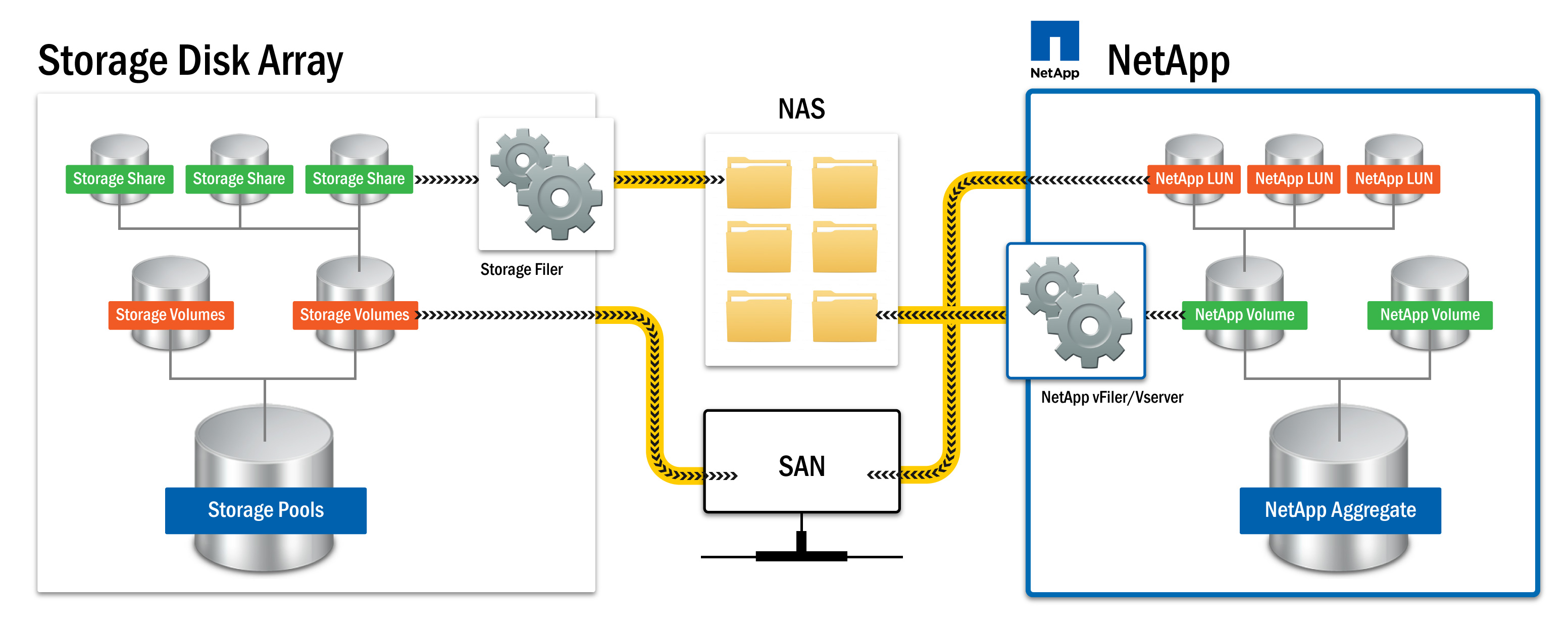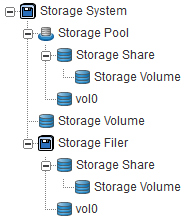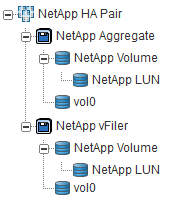Objective
The terminology used in the ETLs developed by Sentry Software for BMC TrueSight Capacity Optimization has been standardized to cover all the different storage manufacturers’ concepts. As a result the terminology may differ from the storage vendor terminology. This is particularly true for the NetApp Data ONTAP ETL.
This article explains the NetApp storage structure and how its specific characteristics can be merged into a common, vendor-agnostic architecture.The NetApp Storage Architecture
History
NetApp Fabric-Attached Storage (FAS) systems are historically dedicated to network attached storage (NAS) technologies. The storage architecture has initially been designed to serve files over network through NAS protocols such as Network File System (NFS), Common Internet File System (CIFS), File Transfer Protocol (FTP), Hypertext Transfer Protocol (HTTP), etc. The hardware and Data ONTAP operating system have been later improved to offer data-block storage features to enable Storage Area Network (SAN) protocols (Fiber Channel, FCoE, and iSCSI) to compete with disk array vendors.
Storage Distribution

NetApp Aggregate
NetApp Aggregate is the initial layer of storage in NetApp. An Aggregate is a RAID-level collection of disks. Aggregates provide storage to volumes. Aggregates can be composed of either disks through RAID-DP or Storage Volumes from the SAN, but not both. Data ONTAP organizes the disks or Storage Volumes in an Aggregate into one or more RAID groups. Aggregates are pools of storage.
NetApp Volume
NetApp Volumes are data containers or partitions of the Aggregate to serve files through NAS protocols supported by Data ONTAP (such as NFS, CIFS, HTTP, and WebDAV). NetApp Volumes form a file system. NetApp Volumes can be partitioned using qtrees that act like a folder hierarchy on a file system with additional features (quotas, oplocks, SnapVault, SnapMirror).
NetApp LUN
Block devices are then built on top of NetApp Volumes. These Logical Unit Number (LUN) devices are accessible through SAN protocols supported by Data ONTAP (FC, FCoE, iSCSI, etc.). Concretely, NetApp LUNs are files available in the file system (NetApp Volume).
Differences with Disk Arrays
The following diagram compares the storage structure between a regular Disk Array and the NetApp system:

NetApp has a completely different architecture for storage components:
- In Disk Arrays, block devices (Storage Volumes) are created in Storage Pools. Then file-serving features (or Storage Shares) are provided by adding a file-system to the volumes and exposing them through a filer.
- In NetApp, file-systems (NetApp Volumes) are created in Aggregates. Block devices (NetApp LUNs) are then provided from the file-systems. NetApp LUNs are actually files.
Another difference is the terminology used. Generally to refer to a block device, Volume is preferred over LUN, as LUN defines an identifier on the SAN and can be bound to more than one block device. Many vendors expose internal block devices as volumes to manage features such as thin provisioning pools extension, snapshots, replication, etc. NetApp uses the term volume for the file systems created in the aggregate and shared on the network through NAS protocols. This naming conflict can be confusing when comparing storage attributes.
NetApp ETL for BMC TrueSight Capacity Optimization
Discovery
The NetApp Data ONTAP ETL developed by Sentry Software discovers the following hardware and logical components from the NetApp systems:
- Controllers (or Nodes in Cluster Mode)
- Ports
- Disks
- vFilers (or Vservers in Cluster Mode)
- Aggregates
- Volumes
- LUNs
All these components are grouped under a Storage System that represents the actual HA Pair (or Cluster).
Entities Created
The NetApp components discovered are created as entities in TrueSight CO. Hardware components (Controllers or Nodes, Ports, and Disks) are imported as sub-objects consolidated in the storage system entity. Logical components dedicated to storage are created using either the Storage -Vendor Agnostic or the NetApp Specific Terminology:
| NetApp Component | Storage - Vendor Agnostic | NetApp Specific Terminology |
| HA Pair | Storage System | NetApp HA Pair |
| Cluster | Storage System | NetApp Cluster |
| vFiler | Storage Filer | NetApp vFiler |
| Vserver | Storage Filer | NetApp Vserver |
| Aggregate | Storage Pool | NetApp Aggregate |
| Volume | Storage Share | NetApp Volume |
| LUN | Storage Volume | NetApp LUN |
We recommend keeping the default Storage - Vendor Agnostic option selected to make the ETL compatible with the Storage Views or to be able to compare multiple SAN vendors without confusion about the terminology (specifically NetApp volumes that are not block devices).
The NetApp-Specific Terminology option should be preferred if you plan to only use the NetApp Data ONTAP ETL or need to provide specific reports usingp the NetApp terminology.
Here are definitions about the entity types used:
Storage System
This entity type represents the whole system including hardware resources. The Storage System displays consolidated capacity and performance metrics and per resource metrics on controllers, ports and disks such as CPU utilization, IOPs, transfer rates and various other metrics. NetApp HA Pair (when using 7-Mode) or NetApp Cluster (when using Cluster Mode) will be mapped to the Storage System entity type.
Storage Filer
A filer is a logical component that represents a NAS server. The filer will expose shares through NAS protocols.
NetApp vFiler (when using 7-Mode) or NetApp Vserver (when using Cluster Mode) will be mapped to the Storage Filer entity type.
Storage Pool
A storage pool is a logical component that provides consolidated (or distributed) space for storage administrators.
NetApp Aggregate will be mapped to the Storage Pool entity type.
Storage Share
A share is a logical device that represents a file system exposed in a NAS network.
NetApp Volume will be mapped to the Storage Share entity type.
Storage Volume
A volume is a logical device that represents a block level data container (or block device) exposed in a SAN.
NetApp LUN will be mapped to the Storage Volume entity type.
Hierarchy and Relations
Hierarchy
Depending on the “Entity Types” configured, the hierarchy tree will differ but all the entities and relations will remain same.
| Storage - Vendor Agnostic | NetApp Specific Terminology | |
| NetApp 7-Mode |  |
 |
| NetApp Cluster-Mode |  |
 |
Relations Created
| Relation between | Storage - Vendor Agnostic | NetApp Specific Terminology |
| Aggregate and the storage system | SA_CONTAINS_SP | NETAPP_CONTAINS_AGGREGATE |
| NetApp LUN and the storage system | SA_CONTAINS_VOLUME | NETAPP_CONTAINS_LUN* |
| NetApp Volume and the storage system | SA_CONTAINS_SHARE* | NETAPP_CONTAINS_VOLUME* |
| NetApp vFiler/Vserver and the system | SA_CONTAINS_FILER | NETAPP_CONTAINS_FILER |
| NetApp Volume and the vFiler/Vserver | FILER_CONTAINS_SHARE | FILER_CONTAINS_VOLUME |
| Aggregate and the vFiler/Vserver | FILER_CONTAINS_SP* | FILER_CONTAINS_AGGREGATE* |
| NetApp LUN and the vFiler/Vserver | FILER_CONTAINS_VOLUME* | FILER_CONTAINS_LUN* |
| NetApp LUN and the Aggregate | SP_CONTAINS_VOLUME* | AGGREGATE_CONTAINS_LUN* |
| NetApp Volume and the Aggregate | SP_CONTAINS_SHARE | AGGREGATE_CONTAINS_VOLUME |
| NetApp LUN and the NetApp Volume | SHARE_CONTAINS_VOLUME | VOLUME_CONTAINS_LUN |
Related Topics
- How is Host Mapping Reconciled in TrueSight Capacity Optimization?
- Generating Log Files for Storage ETLs
- TrueSight Capacity Optimization for Storage: Assessing the Requirements
- EMC SMI-S Agent ETL - Terminology and Computation Methods Simply Explained
- Ensuring Monitoring Studio is Properly Configured to Receive SNMP Traps

